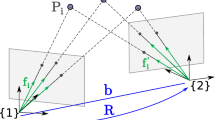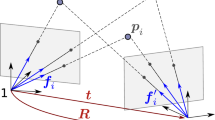Abstract
We propose two minimal solvers to the problem of relative pose estimation for a camera with known relative rotation angle. In practice, such angle can be derived from the readings of a 3D gyroscope. Different from other relative pose formulations fusing a camera and a gyroscope, the use of relative rotation angle does not require extrinsic calibration between the two sensors. The first proposed solver is formulated for a calibrated regular camera and requires four-point correspondences from two views. The second solver extends the problem to a generalized camera and requires five-point correspondences. We represent the rotation part of the motion in terms of unit quaternions in order to construct polynomial equations encoding the epipolar constraints. The Gröbner basis technique is then used to efficiently derive the polynomial solutions. Our first solver for regular cameras significantly improves the existing state-of-the-art solution. The second solver for generalized cameras is novel. The presented minimal solvers can be used in a hypothesize-and-test architecture such as RANSAC for reliable pose estimation. Experiments on synthetic and real datasets confirm that our algorithms are numerically stable, fast, and robust.









Similar content being viewed by others
Notes
Hereinafter, the cameras will sometimes be referred to as regular in order to distinguish them from generalized cameras.
References
Burri, M., Nikolic, J., Gohl, P., Schneider, T., Rehder, J., Omari, S., Achtelik, M., Siegwart, R.: The EuRoC micro aerial vehicle datasets. Int. J. Robot. Res. 35(10), 1157–1163 (2016)
Chen, H.: A screw motion approach to uniqueness analysis of head-eye geometry. In: Proceedings of 1991 IEEE Computer Society Conference on Computer Vision and Pattern Recognition, pp. 145–151 (1991). https://doi.org/10.1109/CVPR.1991.139677
Cox, D., Little, J., O’Shea, D.: Ideals, Varieties, and Algorithms, vol. 3. Springer, New York (2007)
Fischler, M., Bolles, R.: Random sample consensus: a paradigm for model fitting with applications to image analysis and automated cartography. Commun. Assoc. Comput. Mach. 24(6), 381–395 (1981)
Fraundorfer, F., Tanskanen, P., Pollefeys, M.: A minimal case solution to the calibrated relative pose problem for the case of two known orientation angles. In: European Conference on Computer Vision, pp. 269–282. Springer (2010)
Grayson, D., Stillman, M.: Macaulay2, a software system for research in algebraic geometry (2002)
Guo, C.X., Roumeliotis, S.I.: An analytical least-squares solution to the line scan lidar-camera extrinsic calibration problem. In: Proceedings of IEEE International Conference on Robotics and Automation pp. 2943–2948 (2013)
Hartley, R.: In defence of the 8-point algorithm. In: Proceedings and Fifth International Conference on Computer Vision, pp. 1064–1070. IEEE (1995)
Hartley, R., Zisserman, A.: Multiple View Geometry in Computer Vision. Cambridge University Press, Cambridge (2003)
Heng, L., Li, B., Pollefeys, M.: Camodocal: Automatic intrinsic and extrinsic calibration of a rig with multiple generic cameras and odometry. In: IEEE International Conference on Intelligent Robots and Systems. pp. 1793–1800 (2013)
Kalantari, M., Hashemi, A., Jung, F., Guédon, J.P.: A new solution to the relative orientation problem using only 3 points and the vertical direction. J. Math. Imaging Vis. 39(3), 259–268 (2011)
Kukelova, Z., Bujnak, M., Pajdla, T.: Automatic generator of minimal problem solvers. In: European Conference on Computer Vision, pp. 302–315. Springer (2008)
Kukelova, Z., Bujnak, M., Pajdla, T.: Polynomial eigenvalue solutions to the 5-pt and 6-pt relative pose problems. In: British Machine Vision Conference, pp. 56.1–56.10 (2008). https://doi.org/10.5244/C.22.56
Kukelova, Z., Bujnak, M., Pajdla, T.: Closed-form solutions to the minimal absolute pose problems with known vertical direction. In: Asian Conference on Computer Vision, pp. 216–229. Springer (2010)
Lee, G., Pollefeys, M., Fraundorfer, F.: Relative pose estimation for a multi-camera system with known vertical direction. In: Proceedings of the IEEE Conference on Computer Vision and Pattern Recognition, pp. 540–547. IEEE (2014)
Li, B., Heng, L., Lee, G., Pollefeys, M.: A 4-point algorithm for relative pose estimation of a calibrated camera with a known relative rotation angle. In: IEEE/RSJ International Conference on Intelligent Robots and Systems, pp. 1595–1601. IEEE (2013)
Li, H., Hartley, R.: Five-point motion estimation made easy. In: ICPR 2006, 18th International Conference on Pattern Recognition, vol. 1, pp. 630–633. IEEE (2006)
Li, H., Hartley, R., Kim, J.H.: A linear approach to motion estimation using generalized camera models. In: CVPR 2008, IEEE Conference on Computer Vision and Pattern Recognition, pp. 1–8. IEEE (2008)
Longuet-Higgins, H.C.: A computer algorithm for reconstructing a scene from two projections. Nature 293(5828), 133 (1981)
Martyushev, E.: Self-calibration of cameras with Euclidean image plane in case of two views and known relative rotation angle. In: European Conference on Computer Vision, pp. 435–449. Springer (2018)
Nistér, D.: An efficient solution to the five-point relative pose problem. IEEE Trans. Pattern Anal. Mach. Intell. 26(6), 756–770 (2004)
Philip, J.: Critical point configurations of the 5-, 6-, 7-, and 8-point algorithms for relative orientation. Department of Mathematics, Royal Institute of Technology (1998)
Pizarro, O., Eustice, R., Singh, H.: Relative pose estimation for instrumented, calibrated imaging platforms. In: DICTA, pp. 601–612. Sydney, Australia (2003)
Pless, R.: Using many cameras as one. In: IEEE Computer Society on CVPR (2), pp. 587–593 (2003)
Stewénius, H., Engels, C., Nistér, D.: Recent developments on direct relative orientation. ISPRS J. Photogr. Remote Sensing 60(4), 284–294 (2006)
Stewénius, H., Nistér, D., Oskarsson, M., Åström, K.: Solutions to minimal generalized relative pose problems. In: In Workshop on Omnidirectional Vision (ICCV) (2005)
Sturm, P.: Multi-view geometry for general camera models. In: IEEE Computer Society Conference on Computer Vision and Pattern Recognition, CVPR 2005, vol. 1, pp. 206–212. IEEE (2005)
Ventura, J., Arth, C., Lepetit, V.: An efficient minimal solution for multi-camera motion. In: Proceedings of the IEEE International Conference on Computer Vision, pp. 747–755 (2015)
Author information
Authors and Affiliations
Corresponding author
Additional information
Publisher's Note
Springer Nature remains neutral with regard to jurisdictional claims in published maps and institutional affiliations.
The work of E.M. was supported by Act 211 Government of the Russian Federation, Contract No. 02.A03.21.0011.
Rights and permissions
About this article
Cite this article
Martyushev, E., Li, B. Efficient Relative Pose Estimation for Cameras and Generalized Cameras in Case of Known Relative Rotation Angle. J Math Imaging Vis 62, 1076–1086 (2020). https://doi.org/10.1007/s10851-020-00958-5
Received:
Accepted:
Published:
Issue Date:
DOI: https://doi.org/10.1007/s10851-020-00958-5




